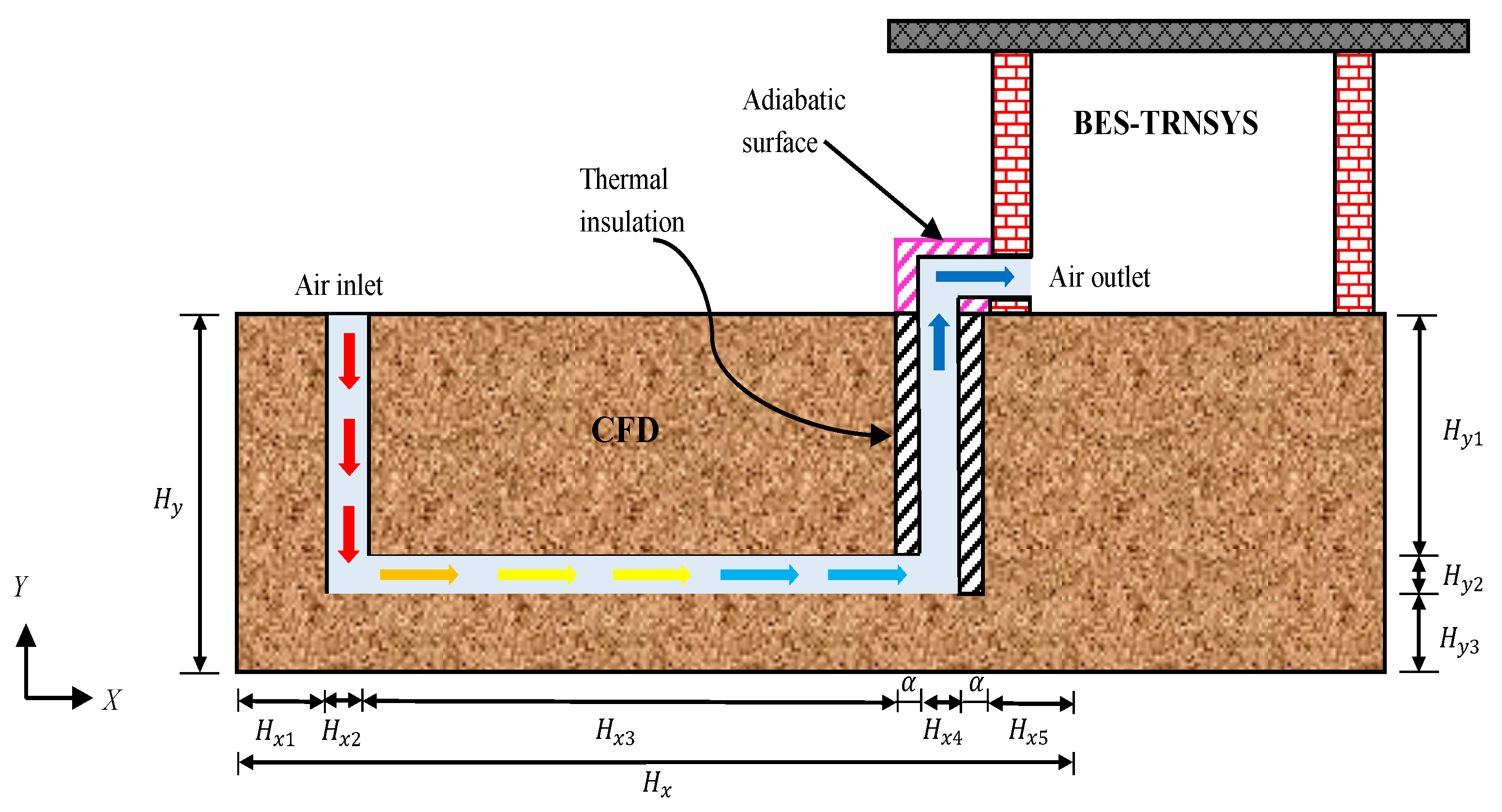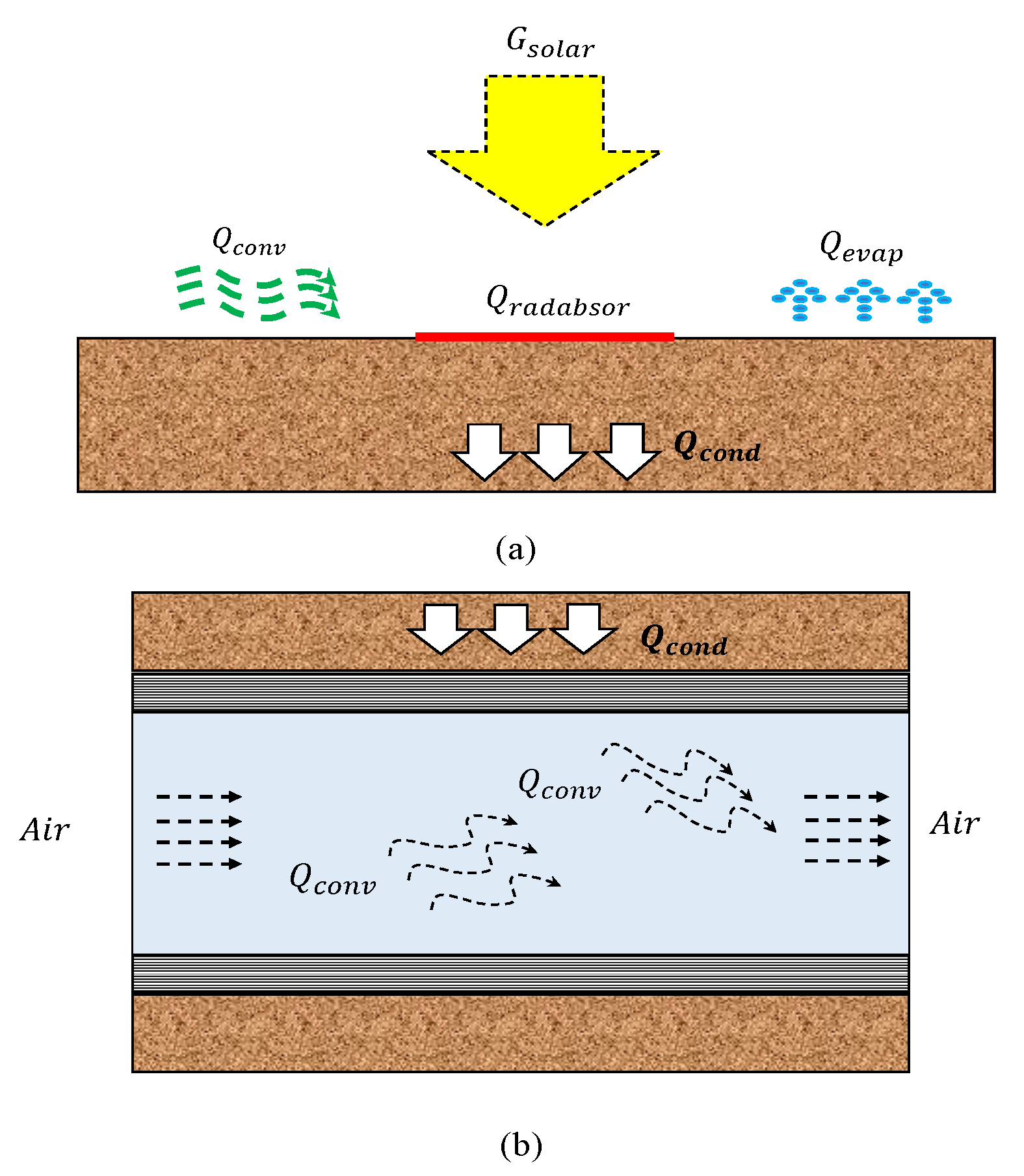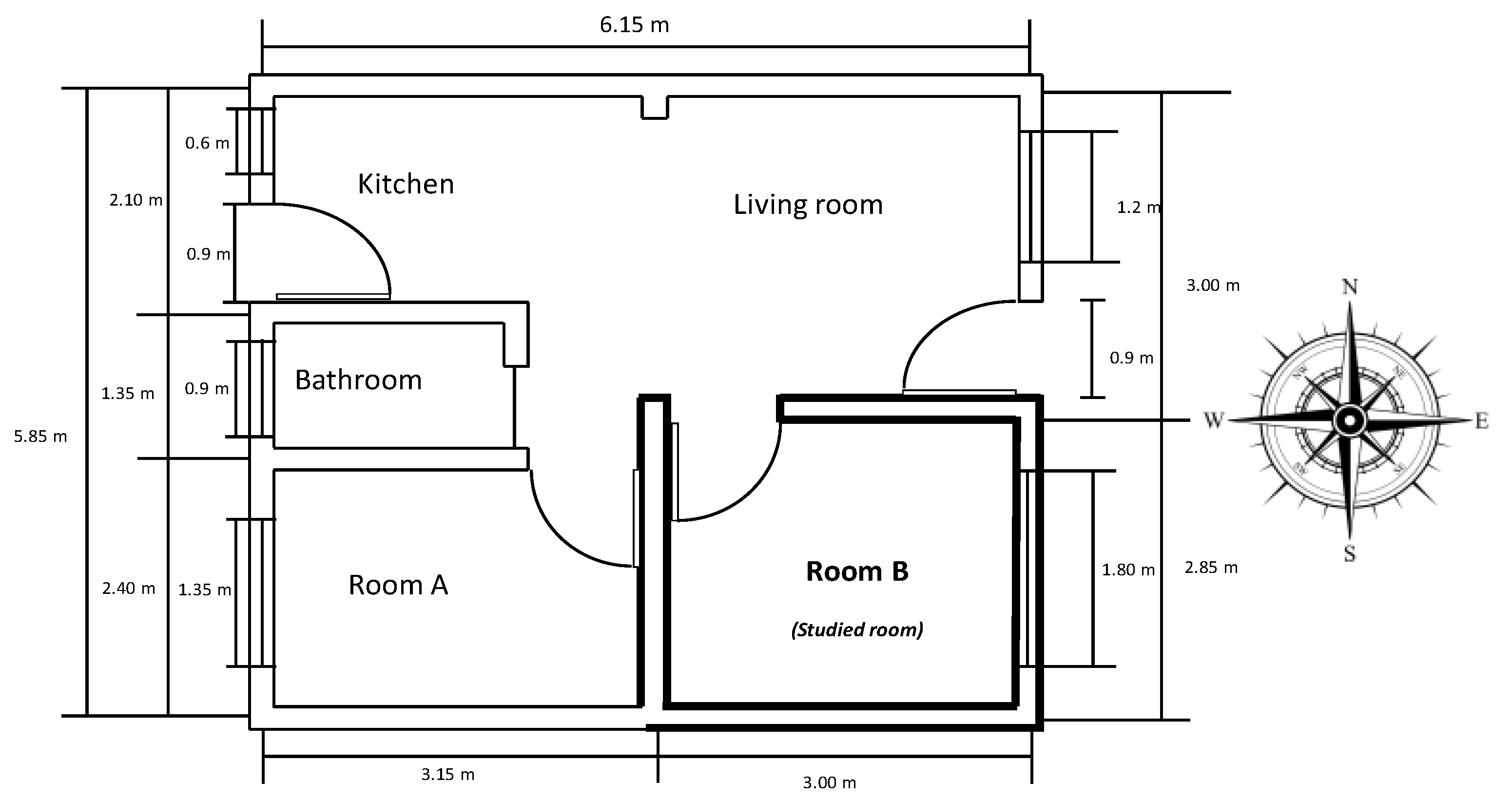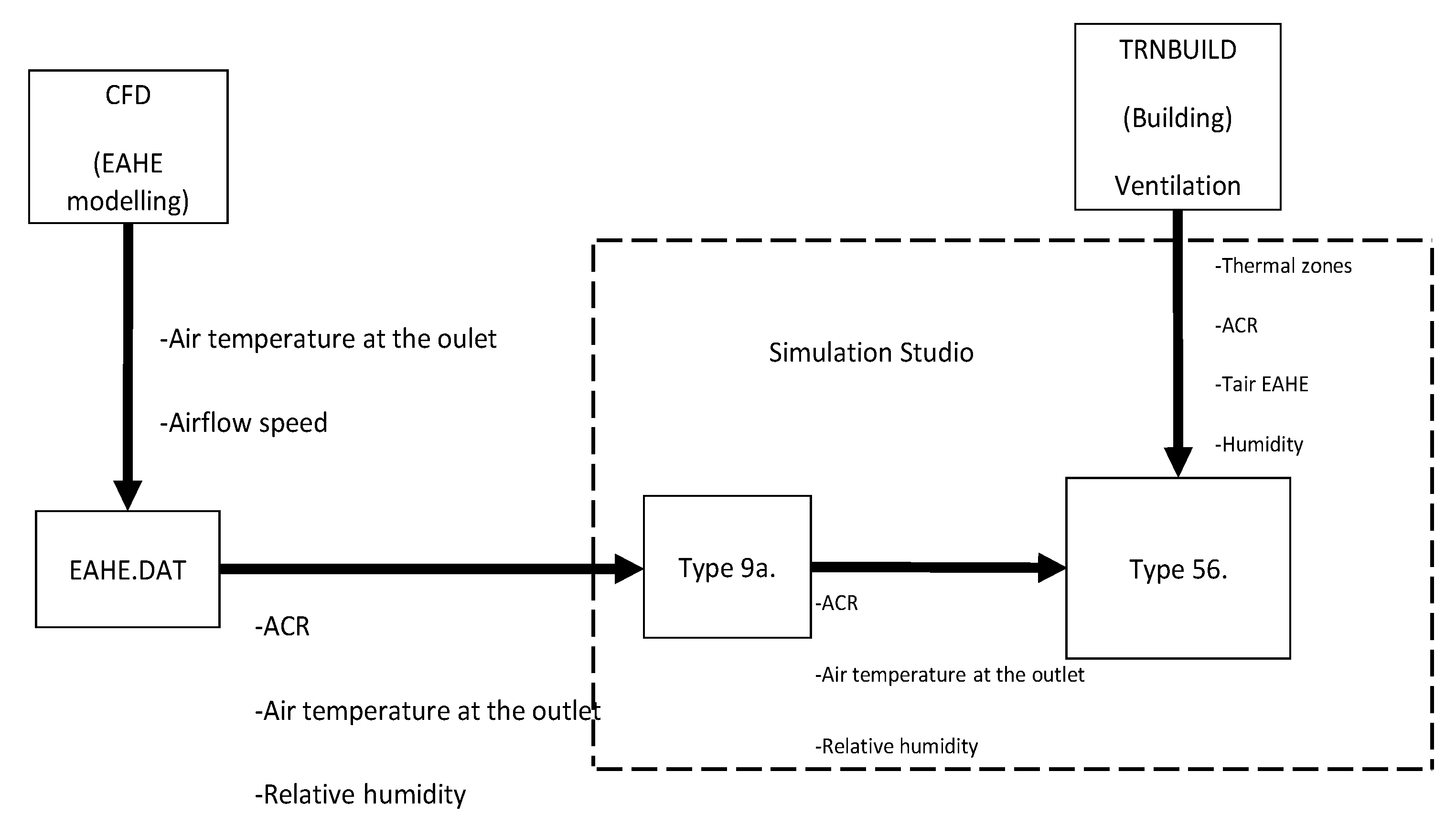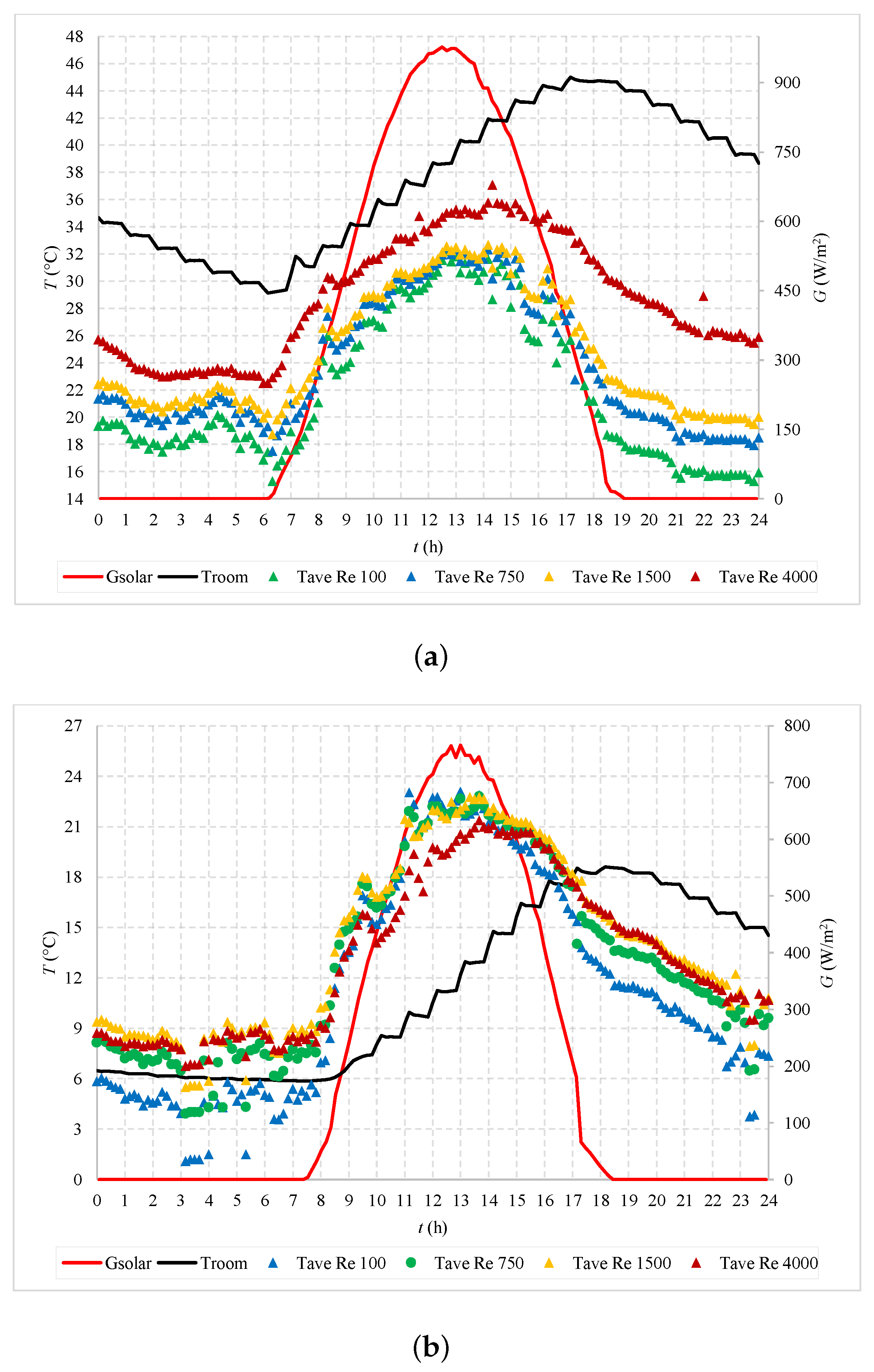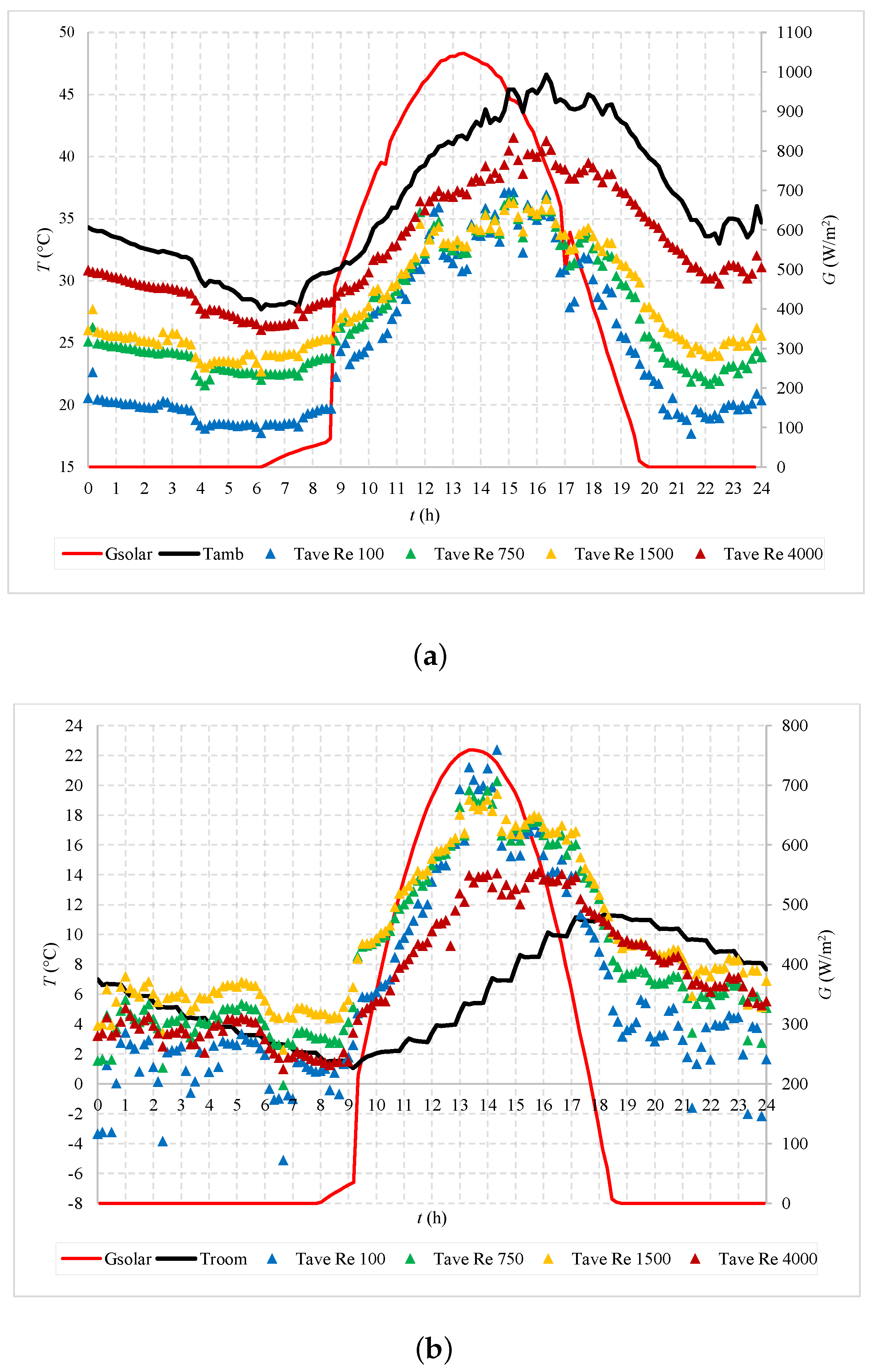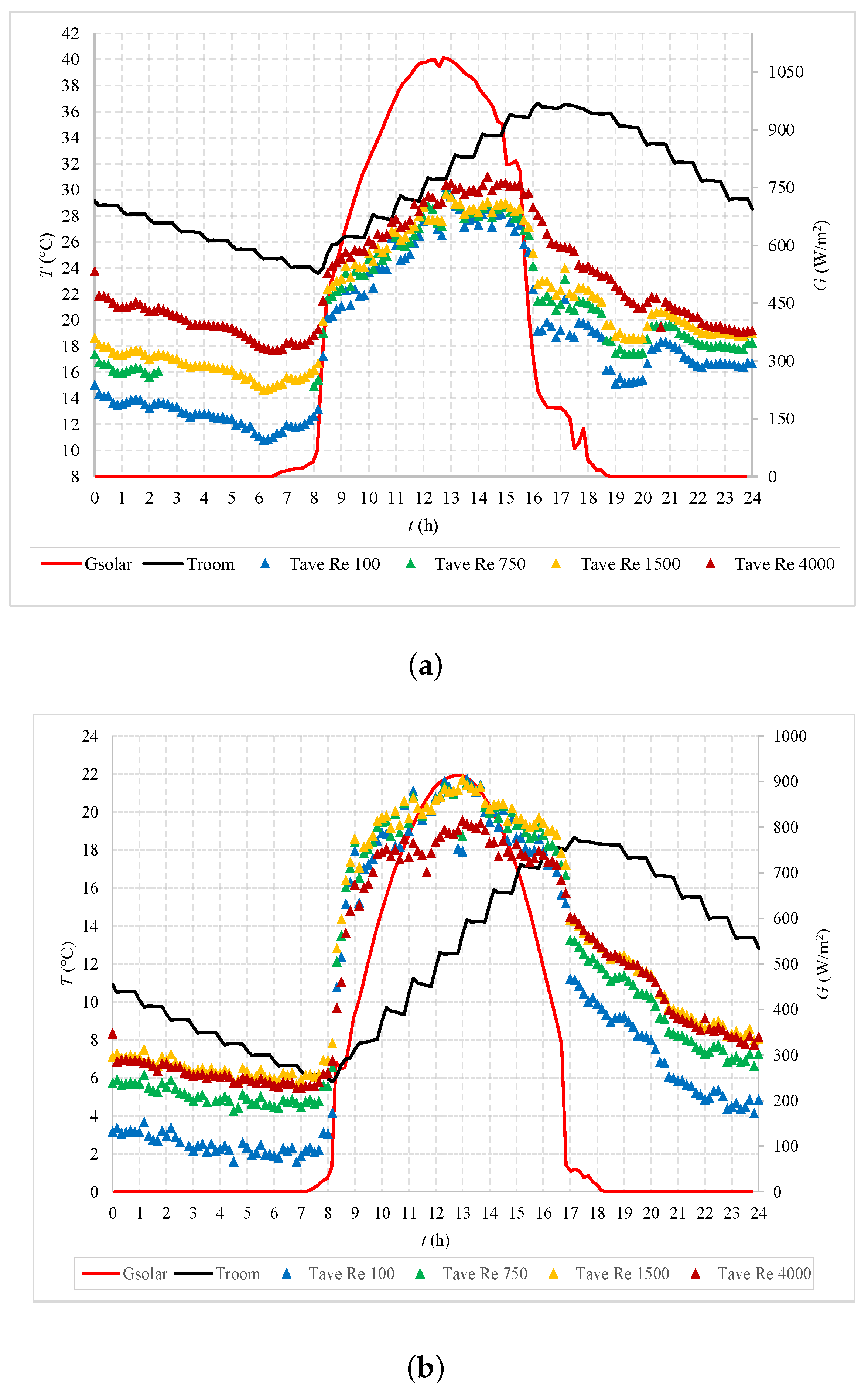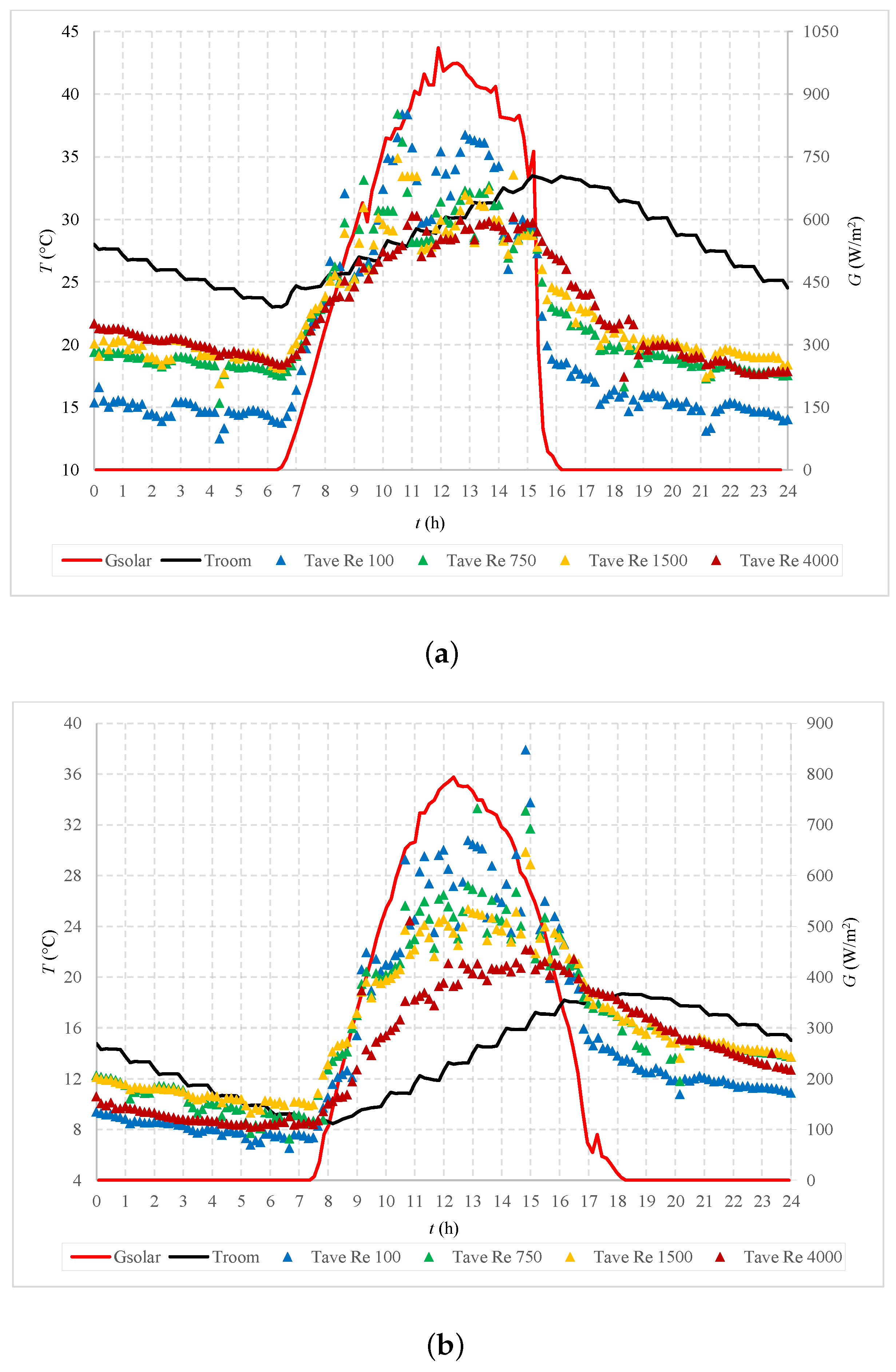This section is divided into two parts. The first part presents the running schedule of the EAHE, which is determined by comparing the temperature of the air at the outlet of the EAHE and the temperature of the indoor air in the room. The second part presents the influence of connecting an EAHE on the indoor air temperatures and cooling and heating loads of the building room.
6.1. Determination of the EAHE Running Schedule
The numerical modeling of the heat exchanger was carried out for different air velocities, according to the Reynolds number in laminar and transitional flow. This section compares the temperature of the indoor air in the room, determined with TRNSYS, and the temperature of air supplied by the EAHE in each city, which was obtained with CFD simulation. This comparison allowed us to discriminate which schedule the EAHE works well with and which it does not. Therefore, if the EAHE does not comply with its duty of cooling or heating as needed, it is supposed that the air from EAHE does not enter the room.
Figure 6a shows a graphical comparison between the indoor air temperature of the room without EAHE and the air temperature at the outlet of the EAHE on the warmest day in Monterrey. Different air velocities for the air into the pipes are presented in the figure as a function of the Reynolds number (
). On this day, the indoor air temperature of the building room ranges between 29.5 and 45 °C. The air from the EAHE is colder than the indoor air of the room the whole day for any value of
. During the first seven hours, between 00:00 h and 07:00 h, the air from the EAHE was up to 15 °C colder than the indoor air. This temperature difference tends to decrease as solar radiation increases; however, it remains below room temperature, with a difference of 7 °C between 7:00 and 13:00 h for small Reynolds values. When the radiation decreases, around 16:00 h, the air temperature from the outlet of the EAHE decreases.
On the coldest day in Monterrey, the air temperature supplied by the EAHE and the indoor air temperature in the room are shown in
Figure 6b. The indoor air temperature of the building room ranges between 6 and 18.6 °C. Thus, the room in this city requires heating to reach thermal comfort, especially the period before 14:00 h.
Figure 6b shows that the airflow provided by the EAHE is warmer than the air in the room during most of the day at high
. As solar radiation increases, this heating effect tends to be greater from 08:00 h, with a temperature difference of about 11 °C. However, as solar radiation decreases, the EAHE loses the heating effect. The supplied air temperature becomes lower than that of the room from 16:00 h, with a temperature difference of about 11 °C. This behavior makes it unfeasible to keep the system running when the room reaches a temperature close to 15 °C; thus, the EAHE could only provide 17 h of heating.
Figure 7a shows the comparison between the temperature of the air supplied by the EAHE and the indoor air temperature of the room in Juárez City. Throughout the warmest day, the air temperature supplied by the EAHE is lower than that reached by the room for all
numbers. But, as
is smaller, the temperature of the air supplied by the EAHE becomes colder than the indoor air. During the first hours, this temperature difference is close to 15 °C when
= 100, which decreases as solar radiation increases after 9:00 h. However, this temperature difference reaches between 7 and 10 °C between 12:00 and 16:00 h. As solar radiation decreases, the supplied air recovers its cooling capacity for the rest of the day, reaching about 27 °C below the indoor room temperature, which provides up to 24 h of cooling effect.
On the coldest day in Juarez City, the EAHE supplies air at a temperature higher than the temperature of the room for most of the day for high Reynolds numbers (
Figure 7b). During the first hours, a cooling effect is obtained by the system towards the room of up to 10 °C; however, as solar radiation increases, the heating effect of the system increases for all
values, reaching a temperature difference of 15 °C between 9:00 h and 14:00 h. This temperature difference tends to decrease as the radiation decreases after 14:00 h, until a cooling effect is obtained again after 18:00 h, so a heating effect of between 9 and 18 h is obtained depending on the speed at which the air is driven by the EAHE.
Figure 8a presents the temperature of the air in the room and the air supplied by the EAHE in Zacualtipan. During the first hours of the day, a significant difference between both temperatures occurs (15 °C). But, during the hours with solar radiation, this difference decreases between 8:00 and 13:00 h, reaching a value between 3 and 5 °C, increasing again after 13:00 h. As solar radiation decreases, the effect of the air provided by the EAHE is cooling for the rest of the day, reaching a temperature difference of 20 °C. Thus, the supplied air temperature is colder than the air in the room the whole day.
Figure 8b shows that the air supplied by the EAHE during the first 8 h has a temperature lower than that of the room on the coldest day in Zacualtipán. As solar radiation increases, a heating effect begins after 8:00 h, reaching a temperature up to 11 °C greater than the indoor air between 8:00 and 13:00 h. Subsequently, once the radiation starts to decrease, a cooling effect occurs again from 16:00 h, with a temperature difference of between 6 and 10 °C, which can be harmful considering that the air in the room reaches values between 10 and 15 °C. The maximum temperature increase is 10.5 °C at 12:50 h, with a heating effect between 8:00 and 16:00 h.
The temperature of the air supplied by the EAHE and the indoor air temperature on the warmest day in Mexico City are presented in
Figure 9a. The temperature of the air provided by the EAHE during the first hours of the day is between 7 and 12 °C lower than the room air temperature. However, in the hours of maximum solar radiation, between 8:00 and 15:00 h, the cooling effect decreases until the supplied air temperature is higher, between 5 and 10 °C, than the indoor air. As the day progresses and the radiation decreases, the cooling effect of the air supplied by the EAHE is recovered; the air supplied by the EAHE had a temperature between 10 and 16 °C lower than the indoor air.
On the coldest day,
Figure 9b shows that when solar radiation is available, the temperature of the air supplied by the EAHE is warmer, between 12 and 18 °C (from 7:00 to 17:00 h), than the indoor air. On the other hand, for hours without solar radiation, the temperature of the supplied air is lower, between 2 and 5 °C, than that reached by the indoor air, which causes a cooling effect. The EAHE provided a heating operation time of 10 h.
Table 6 summarizes the running schedules of the EAHE in the four cities analyzed in this work for the different values of
. The table presents the hours in which the EAHE works well on the warmest day and the hours in which the EAHE works well on the coldest day. These data are presented in the column labeled working time (W.T.). The table also presents the schedules in which the EAHE complies with its cooling and heating duty for the warmest and coldest days, respectively.
6.2. Results of the Simulations of the EAHE Connected to the Building Room
This section presents the analysis of the EAHE connected to a room. The effect of EAHE on the indoor air temperature of the room and its cooling and heating thermal loads is presented here. Such results were obtained by coupling each city’s CFD model of the EAHE and the BES room model.
As mentioned in previous sections, three input data are needed to feed the VENTILATION component in TRNSYS: rate of air changes, the temperature of the air from the EAHE that is injected into the house, and relative humidity. The air change ratio (
) was calculated according to [
64]:
The volumetric flow rate is the product of the average velocity of the fluid at the outlet of the EAHE (
) and the area of the pipe (
A). This volumetric flow is divided by the total volume of the room, in this case, a space of 20.52 m
.
Table 7 reports the
values for each Reynolds number with different numbers of pipes implemented for a room. It is worth mentioning that pipe layout is such that no thermal interference between pipes occurs. The value obtained with one pipe was multiplied by the number of lines to obtain the
for more pipes. As expected, the
increases as the number of pipes and the Reynolds number increase. The peak
= 3.1 1/h is achieved for 20 pipes and
= 4000.
The effect of EAHE with 5, 10, 15, and 20 pipes on the thermal loads of the room was simulated. The maximum number of pipes was selected according to the area of the room (8.55 m
2). As the number of pipes increases, the airflow into the room increases. This is done to increase the
and improve the indoor conditions of the room. The airflow from the EAHE is supplied to Room B, as shown in
Figure 3. The results from simulations of the EAHE connected to the room are presented below. It is worth mentioning that on a warm day, the EAHE only provides air to the room when the supplied air temperature is lower than that of indoor air, while for the coldest day, the EAHE only provides air to the room during the hours when the supplied air is warmer than the indoor air. It is supposed that the outlet of the EAHE is closed when this system does not comply with its duty of cooling or heating when required; in this way, it is avoided by introducing warm air on the warmest day and cold air on the coldest day. Due to restrictions of the numerical code, it is suitable for laminar and transitional flow only, but if it is required to use high air velocities or turbulent regime to achieve a high air change ratio (
), it could not provide reliable results. Thus, it was decided to increase the number of pipes to determine the amount of ACR necessary to generate a significant air change ratio within the room. Implementing 20 pipes in an area of 8.55 m
2 to obtain an air change value that generates a significant effect within the room could be somewhat difficult to carry out; however, within a real system, it is possible to obtain the same maximum value of ACR reported in the study, modifying specific EAHE parameters such as air velocity and pipe diameter to increase volumetric flow, which results in fewer pipes for the same
value. On the other hand, according to the research developed by Minaei and Rabani [
65], it is considered that a separation distance greater than 15 cm does not significantly affect the temperature at the outlet of the EAHE, so if someone wants to implement 20 pipes in the room, 10 pipes can be grouped on the south wall and 10 pipes on the east wall with a separation distance of 15 cm, covering a length of 2.4 m on each side. Another factor that is worth mentioning is the soil thermal saturation. When the EAHE is working, the temperature of the soil surrounding the pipes could increase as time goes on, then after a period between 6 and 12 h of continuous operation, the soil becomes thermally saturated and it could affect the performance of the EAHE [
9]. The soil thermal saturation was not addressed in this work, but it should be considered when intermittent EAHE use is recommended.
Table 8 presents the maximum and minimum indoor air temperatures of the building room without EAHE obtained with TRNSYS and both temperatures when the EAHE is connected to the building room obtained with a CFD-BES coupling. The table presents results for airflow with
= 4000, and it is supposed that twenty pipes are connected to the building room for all cities. Further, the temperature difference (
) between the indoor air temperature of the room without EAHE and with EAHE is also presented. A high Reynolds value was chosen because a high velocity of the airflow supplied by the EAHE favors its mixing with the room’s indoor air.
On the warmest day, the values of for the different cities range between 1.7 and 3.2 °C. The indoor air temperature reduction provided by the EAHE appears to be small, but it is worth mentioning that the room is closed and does not have other infiltration. Although infiltration is a relevant parameter, especially for having a healthy indoor environment, here, infiltration, other than the air introduced by the EAHE into the room, was not considered, because this research aims to focus on the influence of the EAHE on the indoor air temperature of the room. Thus, the indoor air temperature of the room without EAHE and the corresponding temperature of a room with EAHE were compared. Thus, leaving out other parameters could give a better understanding of the behavior of the air in the room with the two conditions mentioned above. In Monterrey, the EAHE was able to reduce the indoor air temperature by 3.2 °C, which is the maximum temperature reduction of all cities. The second more significant temperature reduction occurred in Juárez City with a value of 2.8 °C. Then, Zacaltipán had a temperature reduction of 2.6 °C. Finally, in Mexico City, the EAHE reduced the indoor air temperature by up to 1.7 °C. Thus, on warm days, buildings situated in cities in Mexico benefit from installing EAHE because the indoor air temperature is decreased.
On the other hand,
Table 8 also shows the values of
for the coldest day of the different cities. The values of
ranged between 1.2 and 3.5 °C. In Juárez City, where indoor air reached the lowest value, the EAHE increased indoor air temperature by 3.5 °C. The second more significant temperature increase occurred in Mexico City with a value of 2.3 °C. Finally, the indoor air temperature increase provided by the EAHE in Zacaltipán (1.2 °C) was very similar to that in Monterrey (1.3 °C).
The EAHE connected to a building room can influence the thermal load required to condition the room space. Because the most significant effect on temperature is obtained with the airflow supplied by 20 pipes for the different Reynolds numbers, the cooling and heating loads of the room with EAHE with 20 pipes are presented here.
Table 9 shows the cooling load of the warmest day for each city under study. The values of the cooling load indicate that the thermal load decreases when airflow increases with velocity. The most significant cooling load reduction occurred in Zacualtipán, 2.39 kWh, which is equal to a 6% reduction. The second more significant cooling load reduction was obtained for the room in Monterrey and Juárez City, where the cooling load reductions were similar, with values of 1.64 kWh and 1.61 kWh, respectively. Both values also represent a 2% cooling load reduction. Finally, a minor decrease occurred in Mexico City, with 0.86 kWh (3%). The cooling load reductions are relatively small, but it should be remembered that these values belong to just one day. Depending on the number of days of the year that need cooling in each type of climate, the EAHE could reduce significantly the annual cooling load. Although the previous reductions are small, the year-round savings could be important depending on the type of climate in which the EAHE is installed. Future research should consider the year-round performance of EAHE connected to the building room.
Table 10 presents the heating loads of the building room on the coldest day of the year 2020. The table demonstrates an EAHE with 20 pipes, and
= 4000 provides the most significant room heating load reduction. When the EAHE is installed in the building room in Mexico City, it provided the most significant heating load reduction; it was reduced by 3.51 kWh (11%). In Zacualtipán, the EAHE reduced the heating load by 2.11 kWh, equivalent to 5%. In Juárez City, the heating load was reduced by 0.49 kWh (2%). In Monterrey, the EAHE reduced the heating load by just 0.16 kWh (0.3%). As in the cooling loads, the heating load reductions might be small, but these values belong to just one day. Depending on the number of days of the year that need heating, the EAHE could reduce significantly the annual heating load.
